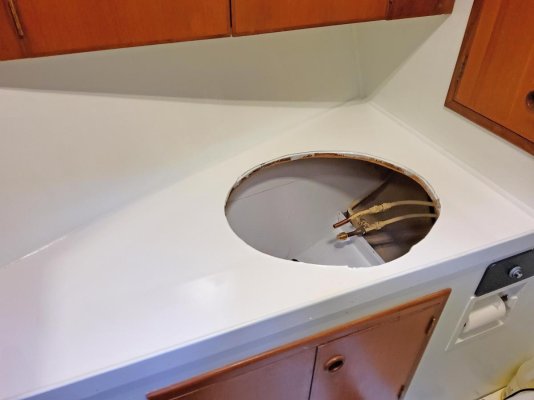catalinajack
Guru
I am replacing two identical oval sinks that are original to the boat. They are beige while the countertops are white, an unattractive mismatch in my view although that is not what prompted me to make the change. The faucet in the forward head had become highly corroded and unsightly. Unfortunately, though I tried mightily, I was unable to remove the faucet.
I was forced to remove the entire sink. I began work in the forward head yesterday and was able to remove the sink without a lot of difficulty even though it had been glued in place with some gooey, black caulk of some sort. I was very afraid that I would have had to smash it to pieces (vitreous china).
Now comes the new install. I will need to bed the new sink and need to ensure a good seal all the way around. I cannot have any voids around the rim that would allow any liquid to find its way underneath the rim. The bedding surface is about 3/4" wide. So, I am looking for a consensus on what use to use to fix it place and ensure no voids. I do have a good supply of butyl tape but I am thinking a caulk is the better choice.
Here's the reason for the absolute need for a good seal. The countertops are beat up. I do not want to spend bookoo bucks on granite, quartz, Corian, or anything of the like. So, my plan is to use pourable, self-leveling, two-part epoxy resin to create a new surface after the sinks are bedded. If there are any voids under the rims of the sinks, the resin will find its way through and may leave a depression there. I have used this same resin to repitch the basin in my shower stall and it worked great. The resin will be tinted to an opaque white to match the sink. This resin is commonly used for bartops and table tops.
I was forced to remove the entire sink. I began work in the forward head yesterday and was able to remove the sink without a lot of difficulty even though it had been glued in place with some gooey, black caulk of some sort. I was very afraid that I would have had to smash it to pieces (vitreous china).
Now comes the new install. I will need to bed the new sink and need to ensure a good seal all the way around. I cannot have any voids around the rim that would allow any liquid to find its way underneath the rim. The bedding surface is about 3/4" wide. So, I am looking for a consensus on what use to use to fix it place and ensure no voids. I do have a good supply of butyl tape but I am thinking a caulk is the better choice.
Here's the reason for the absolute need for a good seal. The countertops are beat up. I do not want to spend bookoo bucks on granite, quartz, Corian, or anything of the like. So, my plan is to use pourable, self-leveling, two-part epoxy resin to create a new surface after the sinks are bedded. If there are any voids under the rims of the sinks, the resin will find its way through and may leave a depression there. I have used this same resin to repitch the basin in my shower stall and it worked great. The resin will be tinted to an opaque white to match the sink. This resin is commonly used for bartops and table tops.

